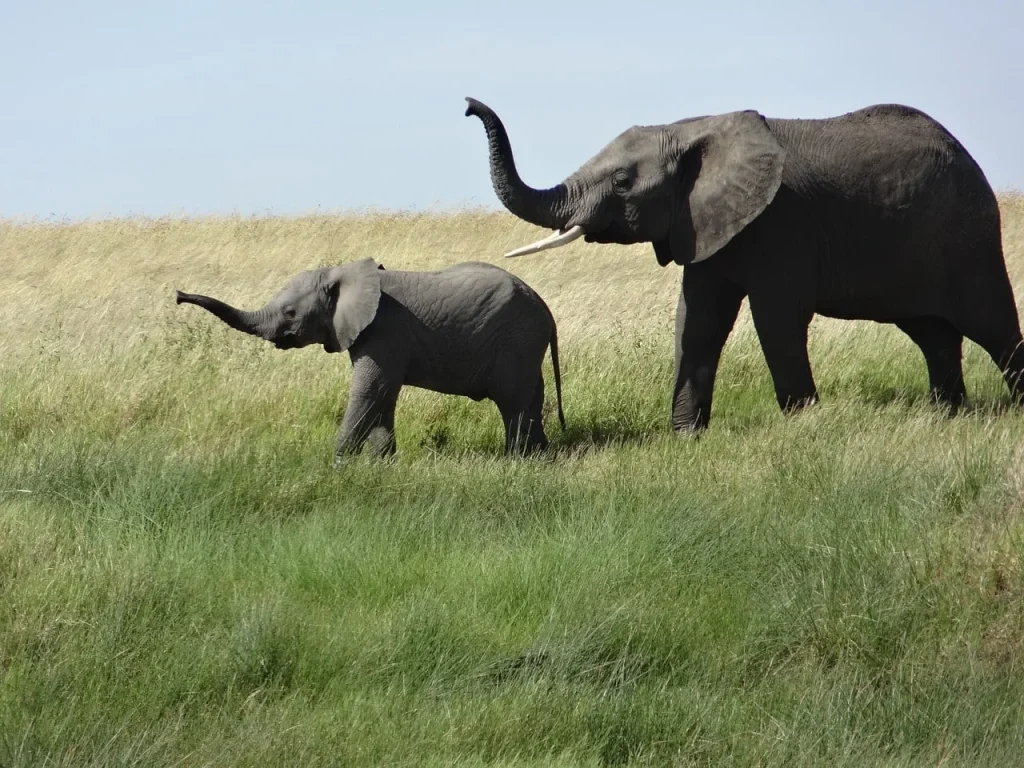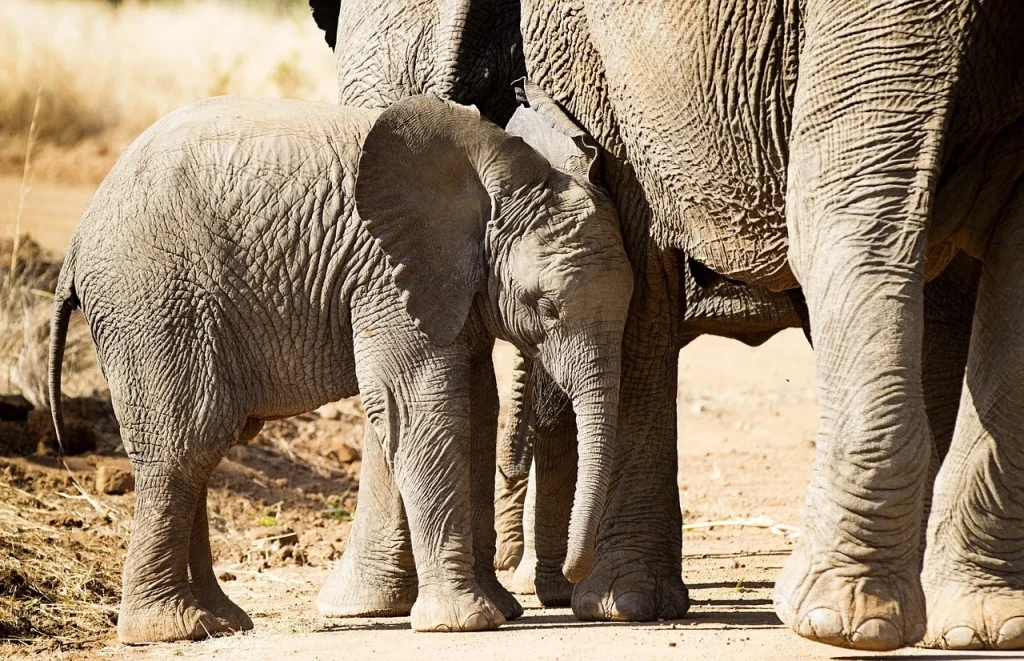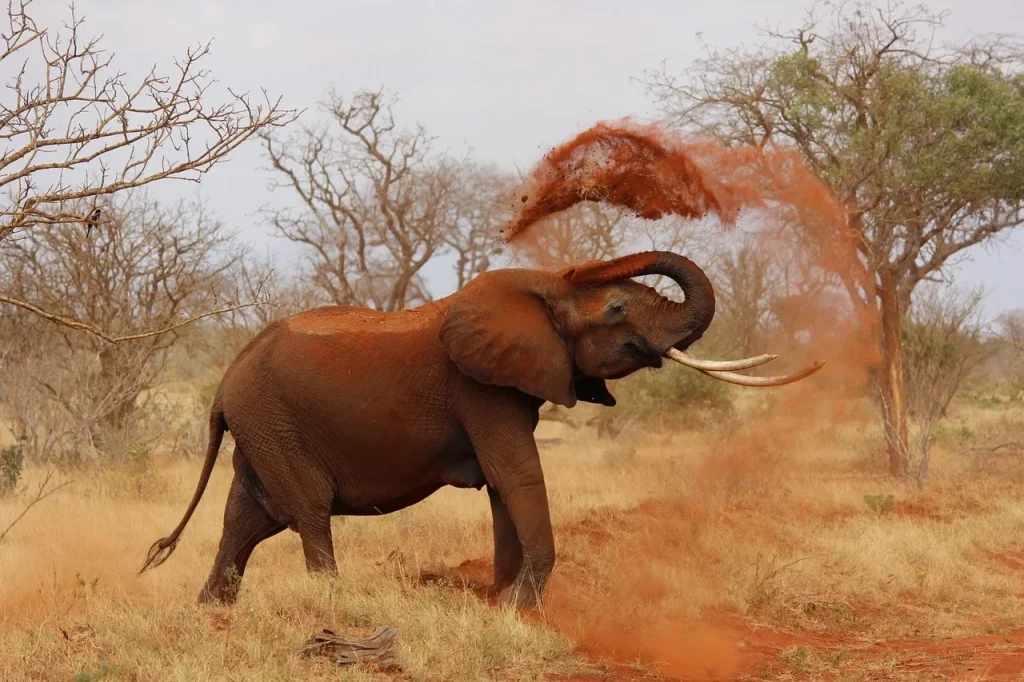Let’s start our journey into the elephantine world with a smile. Did you hear about the elephant who went to school? Neither did we, because they’re already smart enough!
They are truly remarkable, not just for their brain power but for their strength, compassion, and, yes, their enormous ears. I will share some fun facts about these gentle giants that roam our planet. How much do you really know about them? Let’s find out.
Nature’s great masterpiece, an elephant; the only harmless great thing.
John Donne
Elephant Facts
Let’s start our exploration of these majestic mammals. Read each fact carefully, because I created a quiz for you at the end of this article to test your knowledge. Don’t disappoint me.
- These animals have highly developed brains, ranking third in mass behind humans and whales.
- Despite their size, they can walk silently, thanks to the soft pads on their feet.
- Their trunks have more than 40,000 muscles and tendons, providing exceptional dexterity.
- A single individual can consume up to 300 pounds of food in a single day.
- Their skin is an inch thick but highly sensitive, able to feel the slightest touch.
- They produce several types of sounds, some of which are inaudible to humans, for communication over long distances.
- The gestation period for a female is about 22 months, the longest of any land animal.
- These giants engage in mourning behaviors, showing clear signs of grief when a member of their group dies.
- Each individual’s tusks grow throughout its entire life and are actually enlarged incisor teeth.
- They are capable of recognizing themselves in mirrors, a sign of self-awareness only seen in some higher animals.
- Tusks are used to dig for water and minerals, strip bark from trees, and as weapons in fights.
- Matriarchs lead the family groups, using their knowledge of food and water sources to sustain the group.
- Some have been observed using tools, such as using branches to swat flies or scratch themselves.

- Their memories are exceptional, aiding them in recalling vast networks of watering holes over long periods of time.
- Calves are born nearly blind and rely entirely on their mothers and other females in the herd.
- Males often live solitary lives or temporarily form groups with other males after leaving their natal group.
- Infrasonic calls produced by them can travel over 5 miles, allowing communication across great distances.
- Adults spend 12-18 hours a day eating.
- During the dry season, they use their tusks to dig into dry riverbeds to reach underground water sources.
- Their large ears act like radiators to help regulate body temperature.
- These creatures have been known to use mud as a sunscreen, protecting their skin from ultraviolet light.
- Infants are often seen ‘tush nursing’, where they suck their trunk for comfort.
- Seismic communication through ground vibrations picked up by sensory cells in their feet is a critical survival tool.
- Only some Asian males and no females grow tusks, unlike their African counterparts, where both genders have tusks.
- The pads on their feet expand with each step, helping to distribute their enormous weight.
- Older matriarchs tend to be more effective at leading their groups, particularly in times of drought or threat.
- Studies have shown they can recognize human languages, differentiating between those that pose a threat and those that do not.
- Their eyelashes can grow up to 5 inches long, protecting their eyes from debris.

- When swimming, they use their trunk like a snorkel to breathe.
- These animals have a highly developed sense of smell, surpassing even that of dogs.
- Their spine is uniquely shaped to support the weight of their head and tusks.
- Females often give birth to twins, though this is rare and usually only happens once in several births.
- They can live up to 70 years in the wild, depending on environmental and social conditions.
- Conservation efforts for them often focus on anti-poaching measures and habitat preservation.
- They have been observed showing empathy, helping other species in distress, including humans.
- Each individual’s ear shape is unique, much like a human fingerprint.
- Fossil records show that their ancestors roamed many parts of the world, including Europe and North America.
- Their closest living relatives are the dugong and the manatee.

- Facial expressions, although subtle, are a part of their emotional display and communication.
- During musth, a period of heightened aggressiveness, a male’s testosterone levels can increase up to 60 times.
- They are capable of learning sequences of commands and can perform complex tasks.
- Heat stress is a significant issue for them, particularly in captivity, where adequate shade and water may be limited.
- They have a structured social system that includes nursing others’ offspring and forming lifelong friendships.
- At birth, a calf can weigh up to 260 pounds and stand about 3 feet tall.
- Their footprints are unique enough that researchers can identify individuals based on them.
- Mud wallowing not only cools them down but also helps in controlling parasites.
- Their ears can span up to 6 feet wide in African species.
- Herds often forge pathways in the wilderness that other animals use as routes to travel or access water.
- Dust baths are a crucial part of their skin care, helping to prevent infections and sunburn.
- They have a distinct method of communication involving touch, with individuals often seen caressing or wrapping trunks as a sign of affection or greeting.
Elephant Myths

Now that you’ve learned all these interesting facts about elephants, let’s explore further by separating the truths from the myths.
- Elephants are Afraid of Mice
This popular notion has been exaggerated. In reality, they might be surprised by the sudden movements of smaller animals, but they are not inherently afraid of mice. - Elephants Love to Eat Peanuts
Peanuts are not a natural part of an elephant’s diet. They generally consume a vast amount of vegetation, including leaves, bark, and fruit. Peanuts are not typically found or eaten by elephants in the wild. - Elephants Cry Emotional Tears
While they are highly emotional creatures capable of feeling sadness, the idea that they cry emotional tears, as humans do, has not been supported by scientific evidence. - Elephants Have Exceptional Memory
It is true that they have impressive memory skills, particularly when it comes to routes and resources. However, the notion that they never forget anything is an exaggeration of their actual capabilities. - An Elephant’s Tusks Grow Back
Once an elephant’s tusks are damaged or removed, they do not regenerate. Tusks are essentially elongated teeth and, once lost, are not replaced.
No products found.
Elephant Quotes

We continue with some of my favorite quotes about them. Feel free to share yours in the comments so I can add them to the list as well.
The elephant, the huge old beast, is slow to mate.
D.H. Lawrence
D.H. Lawrence, a famous English writer, uses this quote to reflect on the deliberate and majestic nature of elephants, often symbolic of their thoughtful and considered behaviors.
Elephants can sense danger. They’re able to detect a predator’s scent from a mile away.
Zac Efron
Zac Efron, an American actor, highlights the incredible sensory abilities of elephants in this quote, noting their keen sense of smell and awareness of their surroundings.
I have a memory like an elephant. I remember every elephant I’ve ever met.
Herb Caen
This humorous remark by Herb Caen, a celebrated American journalist, plays on the well-known fact that elephants have remarkable memories, aligning it with his own.
If size mattered, the elephant would be the king of the jungle.
Rickson Gracie
Rickson Gracie, a Brazilian martial arts legend, uses this quote to make a point about the importance of skill over size, using the elephant as a metaphor for powerful yet peaceful strength.
The only creature that can go up to an elephant in the forest and tap him on the shoulder is the rain.
Ashwin Sanghi
Indian author Ashwin Sanghi uses this poetic line to express the majestic presence of elephants in their natural habitat and how only the gentle yet pervasive rain can touch them unnoticed.
Elephant FAQ

As you gear up for the upcoming quiz, here’s the FAQ section to cement your understanding of elephants. Read through carefully to ensure you’re fully prepared.
- Why do elephants have big ears?
They have big ears to help regulate their body temperature. The large surface area of their ears allows them to radiate excess heat away from their bodies. Additionally, they can flap their ears to create air currents and further cool themselves down, which is especially useful in their hot, native habitats. - Can elephants paint?
Yes, some of them can paint! They are trained by humans to hold brushes with their trunks and can create paintings that, to some, are quite artistic. This ability showcases their intelligence and fine motor control. However, whether they enjoy it or understand it as an art form is up for debate. - Are elephants endangered?
Yes, they are considered endangered. Both African and Asian elephants face threats from habitat loss and poaching for their ivory tusks. Conservation efforts are ongoing to help protect their populations and ensure their survival for future generations. - How do elephants communicate?
They are highly communicative and use a variety of sounds and physical gestures. They can trumpet to signal alarm or excitement, and they produce infrasound, which is a low-frequency sound below human hearing range, for long-distance communication. They also use touch and visual signals to interact with one another. - Can elephants swim?
Absolutely, elephants are strong swimmers. They use all four legs to paddle and are known to swim long distances. Their trunks act like natural snorkels, allowing them to breathe comfortably while swimming. This ability is useful for crossing rivers and lakes when migrating or searching for food.
No products found.
Elephant Trivia

Welcome to our elephant quiz! If you don’t manage to get a single question right, prepare to be ‘squashed’ under a pile of peanuts!
Elephant Merch
If you are a true elephant fan, then you definitely need to check out our merchandise. You can find T-shirts, hoodies, mugs, and tote bags for your favorite designs. Feel free to check out all the other designs in our shop.
Conclusion
Elephants are more than just a symbol of wisdom and power; they are vital to their ecosystems and to our world’s natural heritage.
As we conclude, remember that protecting them helps us preserve the forests and savannas they call home, which in turn supports our planet’s health.
To finish this journey, I have a question: If elephants could talk, what do you think would be their favorite topic of conversation? Let me know in the comments.


